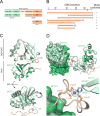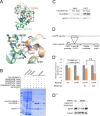DENR-MCTS1 heterodimerization and tRNA recruitment are required for translation reinitiation
- PMID: 29889857
- PMCID: PMC6013234
- DOI: 10.1371/journal.pbio.2005160
DENR-MCTS1 heterodimerization and tRNA recruitment are required for translation reinitiation
Abstract
The succession of molecular events leading to eukaryotic translation reinitiation-whereby ribosomes terminate translation of a short open reading frame (ORF), resume scanning, and then translate a second ORF on the same mRNA-is not well understood. Density-regulated reinitiation and release factor (DENR) and multiple copies in T-cell lymphoma-1 (MCTS1) are implicated in promoting translation reinitiation both in vitro in translation extracts and in vivo. We present here the crystal structure of MCTS1 bound to a fragment of DENR. Based on this structure, we identify and experimentally validate that DENR residues Glu42, Tyr43, and Tyr46 are important for MCTS1 binding and that MCTS1 residue Phe104 is important for tRNA binding. Mutation of these residues reveals that DENR-MCTS1 dimerization and tRNA binding are both necessary for DENR and MCTS1 to promote translation reinitiation in human cells. These findings thereby link individual residues of DENR and MCTS1 to specific molecular functions of the complex. Since DENR-MCTS1 can bind tRNA in the absence of the ribosome, this suggests the DENR-MCTS1 complex could recruit tRNA to the ribosome during reinitiation analogously to the eukaryotic initiation factor 2 (eIF2) complex in cap-dependent translation.
Conflict of interest statement
The authors have declared that no competing interests exist.
Figures




References
-
- Jackson RJ, Hellen CU, Pestova TV. Termination and post-termination events in eukaryotic translation. Advances in protein chemistry and structural biology. 2012;86:45–93. doi: 10.1016/B978-0-12-386497-0.00002-5 . - DOI - PubMed
-
- Andreev DE, O'Connor PB, Loughran G, Dmitriev SE, Baranov PV, a IN. Insights into the mechanisms of eukaryotic translation gained with ribosome profiling. Nucleic Acids Res. 2017;45(2):513–26. doi: 10.1093/nar/gkw1190 ; PubMed Central PMCID: PMC5314775. - DOI - PMC - PubMed
-
- Ingolia NT, Brar GA, Stern-Ginossar N, Harris MS, Talhouarne GJ, Jackson SE, et al. Ribosome profiling reveals pervasive translation outside of annotated protein-coding genes. Cell reports. 2014;8(5):1365–79. doi: 10.1016/j.celrep.2014.07.045 ; PubMed Central PMCID: PMC4216110. - DOI - PMC - PubMed
-
- Wethmar K. The regulatory potential of upstream open reading frames in eukaryotic gene expression. Wiley interdisciplinary reviews RNA. 2014;5(6):765–78. doi: 10.1002/wrna.1245 . - DOI - PubMed
-
- Mohammad MP, Munzarova Pondelickova V, Zeman J, Gunisova S, Valasek LS. In vivo evidence that eIF3 stays bound to ribosomes elongating and terminating on short upstream ORFs to promote reinitiation. Nucleic Acids Res. 2017;45(5):2658–74. doi: 10.1093/nar/gkx049 ; PubMed Central PMCID: PMC5389480. - DOI - PMC - PubMed
Publication types
MeSH terms
Substances
LinkOut - more resources
Full Text Sources
Other Literature Sources
Miscellaneous

